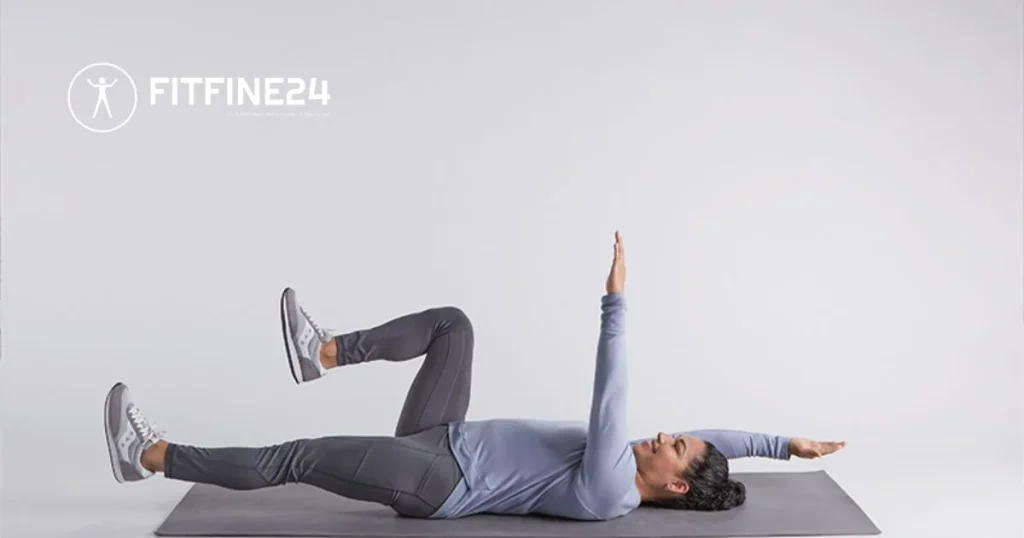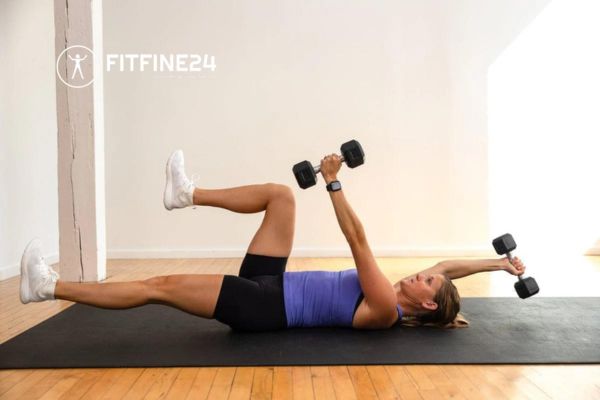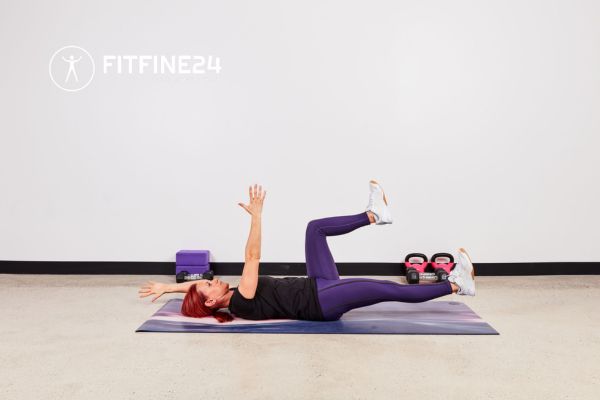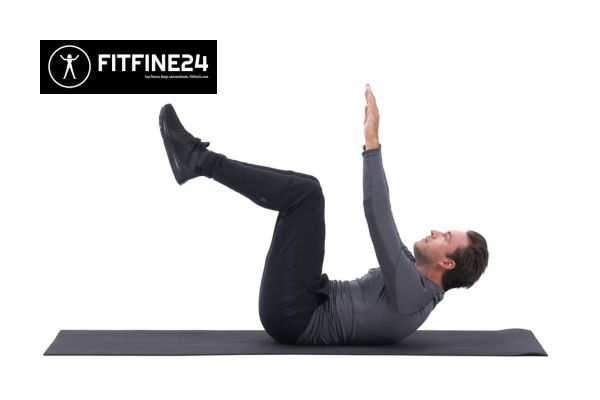
The Deadbug workout is still not maximized enough, even if there are many people out there who appreciate this exercise specifically aimed at developing the core. When people see the Deadbug exercise, the common name of this exercise comes from the way it looks – a bug on its back, it is apparent that this exercise focuses on stressing the muscles of the core. Simple as the movements are and uncomplicated as the exercises are, it still appeals to both new and seasoned fitness practitioners.
In this article, we will look at the benefits, techniques, variations of deadbug workouts, and tips on how to perfect the workouts. Come let fitfine24 take you through how to do this core-building workout effectively so as not to leave its optimal results to chance.
What is Deadbug Workout?
Deadbug workout is a core muscle stabilization-centered activity that consists of simple and controlled reciprocal limb movements (arms and legs) while the person is supine on the ground. Much like how executing the pushup properly is all about maintaining a neutral spine and bracing the core so deadbug performs the lifting action of the deep core with precision to boost good posture and avoid injuries. It is frequently prescribed for people who are trying to recover from or avoid recurring episodes of back pain or who want to enhance their core’s integrity and stability.
The Deadbug Workout may look simple, but it takes focus and precision which makes it an excellent exercise when it comes to core awareness and coordination.
The Muscles Used in The Deadbug Workout
The Deadbug Workout is an exercise with a purpose that works a whole bunch of muscle groups but has more department highlights on the core. The major muscles worked include:
Transverse Abdominis:This is positioned at the bottom layer of the abdominal muscles and assists in stabilizing the pelvis and spine.
Rectus Abdominis: These are the muscles that are popularly called the six-pack muscles and are responsible for flexion of the spine and adding stability to the core.
Obliques:These muscles are situated on either side of the torso and are responsible for controlling and stabilizing rotation.
Hip Flexors: These muscles come into play as the legs are lifted and lowered which is the main activity of this exercise.
Lower Back: This exercise works on the lower back enveloping muscles and prevents back pain by strengthening the supporting structures of the lower spine.
Supposing all that is targeted in the above muscles, theDeadbug Workout not only is good for developing core strength but also helps in improving coordination and enhancing the sense of balance making it an essential exercise for anyone who wants to improve his overall body fitness.
Advantages of the Deadbug Workout
Workouts like the Deadbug Workout offer fitness benefits to individuals of all fitness levels. Some of the distinct merits are as follows

Core Stability:The very first advantage of the Deadbug workout is the stability it provides to the core muscles. A stable core supports better posture and balance while defending the body from the onset of injuries.
Spinal Health:The risk of overexertion of the spine is usually very low when one is doing the Deadbug Workout unlike stick crunches and sit-ups. This makes it safer even among the populations who suffer from back pains or those who are healing from back injuries.
Improvement of Coordination: The upper-arm and bottom-leg movements performed in alternating fashion in the Deadbug Workout also put a strain on self-coordination enhancing its neuro-muscular control.
Low Impact:The deadbug exercise is a relatively low-impact exercisethat is suitable for all fitness levels including beginners or those under rehabilitation.
Functional Strength: Because the Deadbug imitates the same muscle and motion patterns that one does in their daily life, functional strength is improved, thus facilitating safe and easier movements at work.
Better Mind-Muscle Connection: Usually, a dead bug does not allow any abrupt and sudden movements and any such high-speed variation. Instead, every motion done, especially at the entry level, is with slow speed, which emphasizes the right muscles needed and hence the development of brain-muscle coordination.
How to Conduct the Deadbug Movement
It is very important to learn how to do the Deadbug exercise correctly so that the lower back is not overworked and the benefits of the workout are maximized. Here is how to go about it in the most efficient way possible:
Starting Position

Bend your knees at 90 degrees and lift your feet off the floor to position your shins parallel to the ground.
Keeping your elbows straight, raise your arms above your head and in line with your shoulders.
Your lower back should be pressed down on the mat and your abs activated.
Alternating Movements
At an angle, extend your right arm towards the bottom while your left leg is extended in an outstretched position at the same time.
Concentrate on the lower back contacting the surface of the floor to keep a neutral spine. Do not allow extension of the back.
If required, put your left arm and right leg back, then proceed with the movement, and put your right arm and left leg forward.
Center Beliefs
When lowering your arm and leg, take a breath and do the same while returning to the starting position – breathe out.
It is very easy to get carried away and rush the exercise. Instead, all movements should be performed steadily and in a controlled manner. It is important to stay in core stability during the entire range of the exercise.
Intensity and Volume
Try 2-3 sets of 10-12 repetitions on each side. Rotate with 30-60-second breaks between the sets.
Tip:If performing the Deadbug, focus on the quality, as it is always better than doing several repetitions in poor form. In case you notice excessive arch of your lower back or loss of control of the movement, consider minimizing the range of motion to be able to perform the exercise correctly.
Mistakes that should be avoided
The workout is rather straightforward, however, some errors during it can hamper the positive outcome it offers or even result in an injury. Here are a few common errors to watch out for

Overarching the Lower Back: A more common error in the Deadbug exercise is lifting the lower back off the floor. This makes the core less activated which poses a high threat of injury. Do not let your lower back come up on the ground at any time.
Moving too fast through the range of motion:Speed is not the issue in the Deadbug exercise. Doing the movements in a rushed manner causes slack form and lesser use of the core. Perform the movements slowly and deliberately.
Breath Holding:Correct breathing technique is very important in stabilizing the middle of the body. Breathing in should come as the arm and leg goes down and breathing out comes when returning the arm and leg to the original position.
Take note of this limitation and move both legs and arms at the same time though you will not exert too much force on your lower back.
Through such focus on the movement patterns, benefits from the Deadbug are achieved while at the same time preventing unwanted consequences.
Dead Legs and the Variations of its Workout
To renew that core-stability beam’s interest, once a basic Deadbug has been acquired, the more challenging variations can be performed. Some popular variations of the basic dead bug are discussed as follows:
Weighted Deadbug
You don’t have to do away with the challenge as you perform the exercise, just get a light dumbbell or a medicine ball and hold it in your hands during the Dead Bug exercise.
Stability Ball Deadbug
Bend your knees and place your arms out in front of you holding a stability ball between your hands and knees, gently gripping it around as you carry out the movement. This increases the degree of difficulty of the exercise and also the level of engagement of the core muscles.
Resistance Band Deadbug
You can strap a resistance band to an object behind you and hold the other ends with your hands. The resistance band can make the exercise more complicated especially for the upper body during the performance of the Deadbug.
Deadbug with Pause
Keeping the extended position (with arms and legs lowered) for a few seconds, somewhere between 3 to 5, and then resuming the initial position helps in maintaining the elongation of time under tension. This helps in maintaining endurance.
In What Ways Can the Deadbug Be Used in a Workout
The Deadbug can be slotted effectively towards any workout. Below are some means of slotting in it:
Core Engagement: Perform the Deadbug as part of your core workout, combining it with planks, Russian twists, and similar core-strengthening exercises.
Within a Routine as a Warm-Up or Cool-Down:Carry out the Deadbug as one of the warm-up exercises to facilitate core engagement before the compound lifts or as one of the cool-down exercises to promote core control.
Complete Workouts: Performing the Deadbug along with other emerging movements that target other body segments helps the trainees engage their deeper muscle layers.
The next day would include the following:
3 sets of 10-12 Dead bugs on each side.
Rest for 30 seconds between sets.
There is also the option to make it more difficult by using any light weights or holding positions at the extent position alternatively.
Conclusion
As one of the most efficient props for building a strong and stable core, the Dead Bug exercise is functional and safe. This exercise is easy to learn for all levels of fitness and will improve your coroutine courtesy fitfine24.

